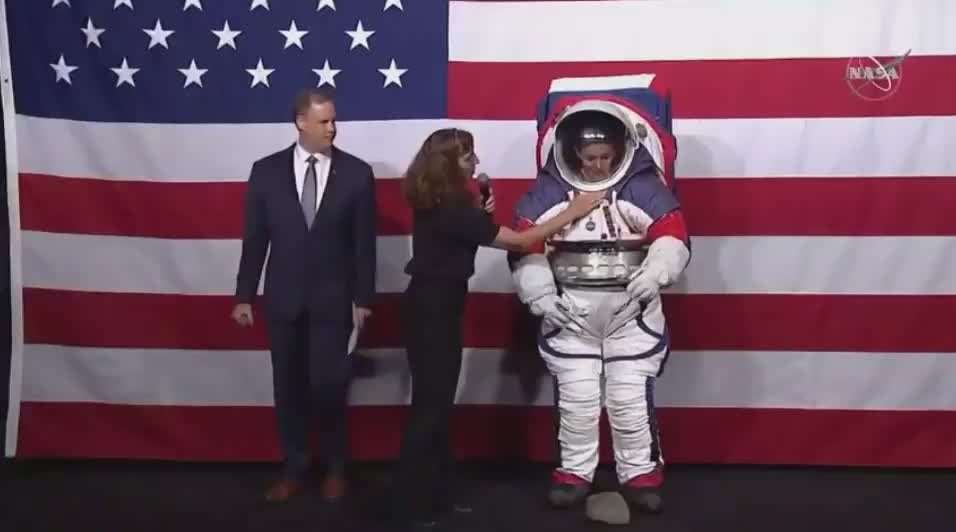WASHINGTON — At NASA headquarters on Tuesday, officials introduced two prototype spacesuits to be used during upcoming moon missions.
The new spacesuits will offer improvements over existing models for the men and women expected to wear them, including greater comfort and movement. And as NASA races to meet the Trump administration’s 2024 target for returning to the moon, the agency needs to make that astronauts have the technological capability to safely set foot on the surface, which no human has done since 1972.
“We’ve been working for a long time to build spacesuits that will do the job on the moon and going on to Mars,” said Amy Ross, a spacesuit engineer at NASA’s Johnson Space Center in Houston.
One spacesuit, with a colorful bright red, white and blue pattern, is called the exploration extravehicular mobility unit. That is what astronauts will wear as they explore the moon’s surface.

The moon suit, demonstrated by Kristine Davis, who works in the agency’s spacesuit engineering efforts, provides additional mobility for an astronaut, making it easier to walk, bend and twist.
Astronauts will be able to reach across the suit and lift their arms above their heads. “Which they can’t do today and couldn’t do during the Apollo program,” Ms. Ross said.
“You remember Neil Armstrong and Buzz Aldrin, they bunny hopped on the surface of the moon,” Jim Bridenstine, NASA’s administrator, said. “Well now we’re actually going to be able to walk on the surface of the moon, which is very different than our suits in the past.”
The suits are designed to work in temperatures ranging from 250 degrees Fahrenheit down to -250 degrees Fahrenheit and potentially even colder places around the lunar South Pole, where NASA is aiming to send astronauts.
The other suit, in a bright orange fabric, is to be worn by astronauts during launch and re-entry back to Earth while they are sitting inside the Orion crew capsule, the spacecraft for deep-space travel that NASA has been working on for 15 years. The suit provides protection and oxygen to the astronauts in case of an accident that causes the capsule to be become depressurized. It is designed to keep astronauts alive for six days.
“The primary use in the case of an accidental depressurization,” said Dustin Gohmert, a spacesuit engineer who modeled the Orion suit. “We can take safe haven in this suit. We’ll seek refuge in here.”
Each outfit shared similarities with its utilitarian predecessors worn by earlier astronauts. Spacesuits being designed elsewhere have more futuristic and fashionable appearances.
SpaceX, which has a contract to fly astronauts to the International Space Station in the near future, sent a mannequin wearing its suit to orbit in March. It featured a 3D-printed helmet and a black and white design that seemed to take inspiration from motorcycle racing suits.
Boeing, whose Starliner will also travel to the station, debuted its blue, zippered suit in 2017. It is about 10 pounds lighter than what astronauts wore on the space shuttle.
NASA’s new suits will be made in a wider range of sizes than had been previously available. In March, a spacewalk that was to be the first conducted by two women, Christina Koch and Anne McClain, had to substitute a male astronaut, Nick Hague, because there were not two spacesuits on the station that fit both women.
(Ms. Koch and another astronaut, Jessica Meir, are scheduled for the first all-female spacewalk this week.)
When the Trump administration announced its intent to send astronauts back to the moon by 2024, NASA was missing a few crucial pieces for the mission. In addition to updated spacesuits, the agency does not currently have a spacecraft capable of landing on the moon.
NASA had been planning to return to the moon in 2028. By moving up the date four years, the leisurely pace had to be greatly accelerated.
The space agency last month issued a call for commercial companies to propose a lunar lander that could be built that quickly. The deadline for proposals is Nov. 1.
NASA officials have insisted the spacesuits would be ready by 2024. That would avert the comical possibility of American astronauts landing on the moon and just looking out the windows without any garments they could wear to step outside.







